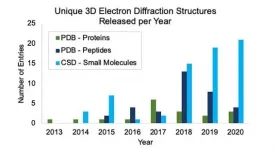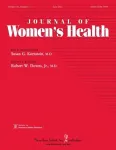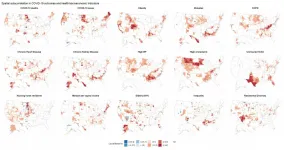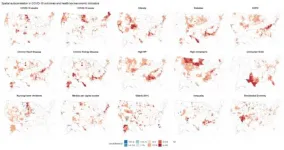Many researchers predicted severe consequences of these physical distancing measures. To understand how this change affected college students' mental health, UW researchers surveyed 147 UW students over the 2020 spring quarter, which began shortly after the university transitioned to online-only classes. The team compared the students' responses to a previous survey of 253 students in spring quarter 2019.
The researchers didn't see much change in average levels of students' depressive symptoms, anxiety, stress or loneliness between 2019 and 2020 or between the beginning and the end of spring quarter 2020. But these average values were masking large differences in students' individual pandemic experiences. In general, students who used more problem-focused forms of coping -- creating plans, focusing on positive aspects, etc. -- experienced fewer mental health symptoms than those who disengaged or ignored a situation that was bothering them.
The researchers published these findings June 28 in PLOS ONE.
"During the pandemic, the challenges of online learning were entwined with social isolation, family demands and socioeconomic pressures," said lead author Margaret Morris, an affiliate associate professor in the UW Information School. "There's not a simple answer to the question of how students were affected: Some experienced intense distress while others were unscathed."
For the past four years, this team has spent spring quarter studying what factors contribute to undergraduates' overall mental health and well-being. Students are invited to continue participating in each spring quarter study, and the researchers also recruit new students each time. In a previous paper, the researchers found that experiencing discrimination events altered student behavior, such as the amount of sleep or exercise a student got following the event.
For the 2020 cohort, the team used three different survey methods to monitor student health. First, they sent large surveys at the beginning and end of spring quarter. Then participants received two shorter surveys each week that asked them to reflect on how they felt -- in terms of stress, loneliness, depressive symptoms -- in the moment.
In general, students who reported more mental health symptoms at the beginning of the pandemic continued to experience elevated symptoms during the pandemic.
"Problem-focused coping protected students from the harmful effects of stress (anxiety and depression, for example), even though students who used more problem-focused strategies reported more stress," said co-author Kevin Kuehn, a UW doctoral student in clinical psychology.
"What these findings suggest is that students who coped by actively confronting their challenges, rather than avoiding them, still experienced highly stressful events over the course of the pandemic. However, they were protected from the mental health consequences," Kuehn said. "It may not always feel pleasant or easy to confront the challenges of daily life, particularly during a pandemic, but doing so is likely to be highly beneficial in terms of reducing anxiety and depressive symptoms."
Finally, at the end of spring quarter, the team conducted 90-minute in-depth interviews over Zoom with a subset of participants to gain deeper insight into their experiences.
The students described a range of challenges that interfered with learning: ? Decreased interaction with faculty and peers -- students mentioned that having fewer opportunities to interact with faculty and peers left them feeling less engaged. Some students said they felt like part-time students, even when they had full course loads ? No shared learning environments -- students spoke longingly of a table in a dorm or a spot in the library where they used to gather with classmates for impromptu study sessions ? Family needs -- family members' requests or noise often interrupted studying and even test-taking. Family needs, such as caregiving, were a particular challenge to learning for first-generation college students ? Interrupted autonomy -- some students felt "trapped" back at home and described difficult "power dynamics" with their parents ? Well-being and mental health -- many students described disrupted sleep, decreased motivation, and said that they felt depressed or anxious for periods of time. Students' feelings of detachment from school sometimes contributed to depression. Similarly, worry about grades sometimes cascaded into anxiety and insomnia that, in turn, made it harder to focus
Students also developed strategies to combat these challenges, including: ? Self-learning -- students used independent online research to figure out answers to their questions and made up their own experiments to explore what they were learning in class ? Structuring routines and environments -- many students created fixed schedules for studying or used physical calendars to mark timelines and assignments ? Learning with peers -- students created remote study groups and held informal remote co-working sessions that combined homework with personal conversations, which helped keep them on task ? Participating more in online spaces -- many students found it less daunting to ask questions in online classes than in large lecture halls, others found it easier to participate in online office hours and meetings with advisers ? Using communication platforms for emotional wellbeing -- some students used telehealth or meditation apps, but almost all of them used video communication to check in with their friends. Students emphasized that these connections were critical for their mental health
"On an optimistic note, students are emerging with critical skills for learning and maintaining connectedness with peers over a distance," Morris said. "These active coping skills, which include things such as initiating virtual co-working sessions, leveraging online functions to participate in class and checking in on friends in an emotionally sensitive way, will have continued value as we resume in-person and hybrid models of education."
The team plans to follow students through all four years of their time at the UW. The first study cohort graduated this year, and the second cohort will graduate in spring 2022.
INFORMATION:
Additional co-authors are Jennifer Brown, an alumnus of the UW school of public health who is the research coordinator for this project; Paula Nurius, a professor in the UW School of Social Work; Han Zhang and Yasaman Sefidgar, UW doctoral students in the Paul G. Allen School of Computer Science & Engineering; Xuhai Xu, a doctoral student in the Information School; Eve Riskin, a UW professor of electrical and computer engineering; Anind Dey, professor and dean of the UW Information School; Sunny Consolvo, a researcher at Google; and Jennifer Mankoff, a professor in the Allen School. This research was funded by the National Science Foundation, the National Institute of Mental Health, Google, the Allen School, UW Department of Electrical & Computer Engineering, the UW College of Engineering and the UW Population Health Initiative.
For more information, contact Morris at margiemm@uw.edu.





